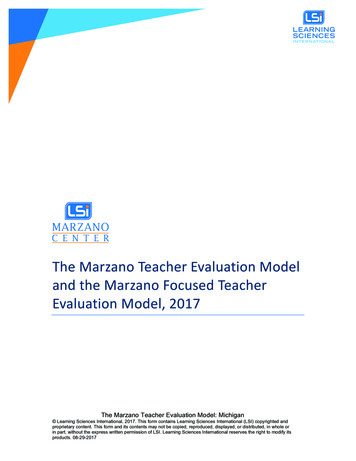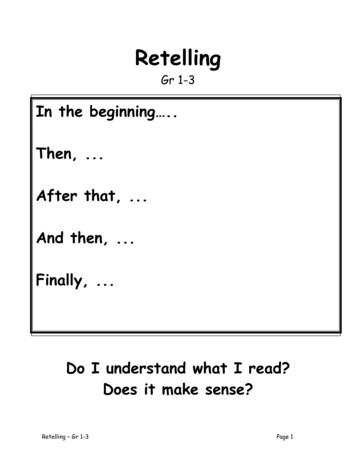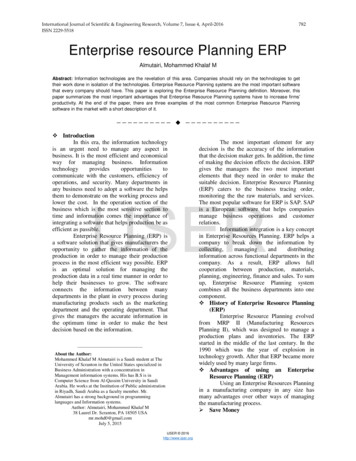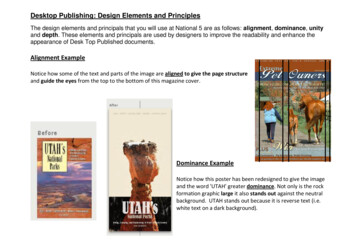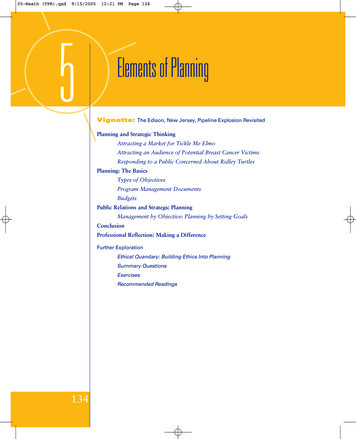
Transcription
05-Heath (TPR).qxd9/15/2005512:21 PMPage 134Elements of PlanningV i g n e t t e : The Edison, New Jersey, Pipeline Explosion RevisitedPlanning and Strategic ThinkingAttracting a Market for Tickle Me ElmoAttracting an Audience of Potential Breast Cancer VictimsResponding to a Public Concerned About Ridley TurtlesPlanning: The BasicsTypes of ObjectivesProgram Management DocumentsBudgetsPublic Relations and Strategic PlanningManagement by Objective: Planning by Setting GoalsConclusionProfessional Reflection: Making a DifferenceFurther ExplorationEthical Quandary: Building Ethics Into PlanningSummary QuestionsExercisesRecommended Readings134
05-Heath (TPR).qxd9/15/200512:21 PMPage 135Vignette:The Edison, New Jersey, Pipeline Explosion RevisitedLet’s return to the vignette we introducedat the beginning of Chapter 1. Thatvignette gives us the opportunity to applymuch of what we have learned since Chapter 1.The vignette in Chapter 1 focused on apipeline explosion in Edison, New Jersey. Wepromised that we would return to that case andtell you how the crisis was managed. Promisekept! The vignette sets up the discussion ofstrategic public relations planning to buildrelationships, the theme of this chapter.Soon after the explosion occurred, the mayorof Edison blamed the pipeline company TexasEastern Transmission (TETCO), a subsidiary ofDuke Energy (formerly Panhandle EasternTransmission). A public recognized a problem andsought someone to blame for the problem. Publicswere cognitively involved with the problem; theysaw it as related to their self-interests. The mayorsaw the explosion in his political self-interest. HeSuccessful Response to Community Relations Crisiswanted to protect the interests of his constituents.SOURCE: Reprinted with permission by the Public RelationsSociety of America (http://www.prsa.org).The crisis was detected by the apartmentdwellers, who heard and felt the explosion.(Luckily, no one was seriously injured.) The crisisattracted network news attention in New Yorkthe crisis response team arrived in Edison, theyCity. Company pipeline crews noted a problem andwere confronted with angry citizens, angrybegan immediate crisis mode actions. TETCOofficials—the start of a public that was looking tomanagement in Houston was alerted. It marshaledform and take action against the company. To themits forces and flew to Edison.and others, the explosion scene resembled aThe crisis response team consisted of crisisbattlefield with damaged buildings, burned-outresponse experts and senior management,automobiles with melted headlights that had aincluding the vice president of public affairs. Whencomical “teary” look, and a crater 120 feet wide135
05-Heath (TPR).qxd9/15/200512:21 PMPage 136Vignette:The Edison,New Jersey,Pipeline Explosion Revisitedcontinuedand 60 feet deep. The explosion displaced 2,000To accomplish these three priorities, TETCOpeople. Many were without more clothing thanknew that it had to build (rebuild) a relationshipthey had grabbed as they fled their apartments.with the mayor, community members, and otherBy the time the crisis response team arrived inelected officials (including those at the federal level)Edison, it had formulated its specific crisisto solve this problem, restore people’s lives as wellresponse, which focused on three priorities. Eachas could be done, and put the pipeline back intopriority was designed to demonstrate that TETCOservice. The company wanted to use public relationswas a good company that wanted a mutuallyto achieve a mutually beneficial relationshipbeneficial relationship with members of the(collaborative decision making).community where it operates, a key to buildingcommunity relationships:Priority 1:Care for victims. A fund of 7 to 10million was allocated to assist thePriority 2:of the explosion and half a continent away fromcorporate headquarters. One of the first steps wasto begin to contact local community groups. One ofvictims. 5,000 was given to familiesthese was the local branch of United Way. Since thewhose apartments were burned, andcompany had no reputation with this particular 1,000 was given to other families asgroup, its leaders were encouraged to contact theneeded. In addition, 350 per person,head of United Way in Houston. She spoke highlyper week was paid to cover livingof the corporate good citizenship of the company.expenses, and the company coveredThat report laid a foundation of trust with keytemporary housing costs for 2 months.groups in Edison. In this way, TETCO used oneTeams were assigned to assist victimsmutually beneficial relationship to create, maintain,and work with local officials.or repair the relationship with the citizens ofAssist and cooperate with the NationalTransportation Safety Board (NTSB),the federal agency that overseespipeline safety. Investigation revealedthat third parties had damaged thepipeline when they buried parts of aPriority 3:It began to implement its plan within 12 hoursEdison.In the days that followed, the team fieldedhundreds of media inquiries. The media swarmedto the site because the fire was visible fromNew York City, it was close to major mediapickup. The NTSB quickly concludedcenters, and it was a dramatic human interestthat TETCO was not liable for the fire.event. As everything seemed to be moving towardRestore the pipeline into service. It is anormal and the pipeline neared going intomajor transportation line for providingoperation, the local mayor called on a countynatural gas to users in the Northeast.judge to impose a restraining order that prevented136
05-Heath (TPR).qxd9/15/200512:21 PMPage 137the company from putting the pipeline intogood company being opposed by a bad mayor—operation. The company knew it would win a courtone motivated by political gain. This story shiftedbattle. The NTSB ruled that it was not responsible(redefined) the anger of the community from thefor the explosion and the county judge could notcompany to the mayor, who was playing politics.impose such a rule in a federal matter. But if a bigThis evaluation led the mayor to negotiate a seriescompany crushes a small-town mayor, theof steps that led to a media event. At that event, thecompany loses as it seeks to win.mayor and a senior TETCO official cooperated inThus, the company opted for a communicationgiving the order and taking the actions to put thewin instead of a legal win. It went to the mediarestored pipeline back into service. A goodwith facts about how it had assisted victims, evencompany had communicated effectively to achievethough the company was not liable. It applieda mutually beneficial relationship with its keyprinciples of narrative theory and told a story of amarkets, audiences, and publics.Today’s public relations requires planning and strategic thinking.The public relations plan of an organization must fit with and support its strategic business plan. This is true regardless of whether theorganization building public relations is a business, a nonprofit, or agovernmental agency.Public relations planning is no different from other kinds of planning. It requiresresearch, planning, taking action, and evaluation. Chapter 4 discussed research. Thischapter focuses attention on how research is incorporated into planning to formulatethe actions that need to be taken. Chapter 6 will describe how to take action. Chapter 7will explain how to evaluate the success of the plan and its implementation.Planning and Strategic ThinkingPractitioners learn to think in terms of a formula of steps. Research. Plan. Implementthe plan. Evaluate the plan. Refine the plan. Implement the plan, and so forth. Thesesteps capture the essence of the strategic thinking public relations managers use tomake their organization or unit more effective. Public relations practitioners increasetheir effectiveness by helping to develop the organizational plan and by using publicrelations planning to enhance the total organization.137
05-Heath (TPR).qxd9/15/200513812:21 PMPage 138Today’s Public RelationsEffective management along with effective public relations requires two levels ofplanning. First, the organization must have a plan to accomplish its mission and vision.Each department, as well, must have a plan to accomplish the objectives needed toassist the total organization in its efforts to be effective. Thus, a public relations department has a master plan. To foster appropriate relationships with each of its markets,audiences, and publics (MAPs), it should also have a plan.TETCO had a community relations plan, one needed to create and maintain (evenrepair) relationships between the organization and the citizens in communities whereit operates. Once the explosion occurred, that community relations plan and even itsoverall crisis response plan became the framework for developing, implementing,and evaluating the specific plan that would be used to restore its relationship withthe citizens of Edison, New Jersey. It used that plan to accomplish the corporate planof restoring the operation of its pipeline.In most cases, an organization does not succeed by accident. Leaders of successfulorganizations think strategically; they act purposefully. Strategic organizations formulate plans to guide their actions in a specific direction; they know where they are goingand how to get there. Successful public relations practitioners must have a strategic focusas well.Imagine you want to drive from Chicago, Illinois, to Columbus, Ohio. You couldget in a car and begin driving southeast, taking any road that sent you in the desireddirection. That is not a strategic approach, although it might be fun and might eventually lead you to your destination. To be strategic, you could conduct research. Foryour research, you might buy detailed maps or use an Internet map, plot the quickest route, and locate places to stop to eat and to buy gas. You might use the Web tocheck on road construction. That would be a strategic approach.Public relations entails building relationships with MAPs. To help set the tone fordiscussing strategic planning, you need to consider the planning challenges that are central to the following cases. One case asks you to consider what plan you would developto achieve the objective of creating market interest through publicity for a new toy called“Tickle Me Elmo.” Another raises the question of how to attract an audience to information relevant to breast cancer. The last focuses on a public that can affect how anindustry, shrimpers, operates. Mature public relations practitioners think in terms of MAPs.䊳 Attracting a Market for Tickle Me ElmoImagine for a moment that you work in the public relations department for a nationaltoy company. A new toy is being introduced for the holiday. The marketing plan isto sell at least 400,000 units. It is a Sesame Street “muppet.” The public relationsplan calls for publicity efforts to increase awareness of the toy. Your boss asks youto handle the campaign and wants a plan in 2 days. What do you do?Here is an actual answer to that question. A toy company sought to attract attentionof its key market—persons who purchase toys for children. Publicity campaigns are oftenused to attract the attention of a market to a product designed to appeal to that market.This particular publicity campaign launched a new toy so effectively that demand outstripped supply. The most sought-after toy during that holiday season was “Tickle MeElmo,” produced by Tyco Toys, Inc. This Sesame Street muppet was predicted to sell
05-Heath (TPR).qxd9/15/200512:21 PMPage 139Elements of Planning400,000 units. Freeman Public Relations, Inc., wantedto give the product a boost, with the objective of achieving or exceeding this sales objective. Using a strategysimilar to that employed to promote the “CabbagePatch” dolls several years before, Freeman sent a TickleMe Elmo to TV talk show host Rosie O’Donnellfor her 1-year-old son. Then, the company sent 200more Elmos to her. She used them on air as rewardsfor members of the audience who said the word “wall.”Her guests that day were actor Tom Hanks, comedianDom DeLuise, singer Willie Nelson, and CliffyClinkscales, an 11-year-old basketball whiz. The guestswere charming and played with the dolls. This publicity effort increased sales. Store clerks were inundatedwith requests for Elmo. Parents worked hard to buy oneso as not to disappoint their children. This most soughtafter toy surpassed the 400,000 initial business plan projection and sold over 1,000,000 units. The rhetoricalobjective was to attract favorable attention and to provide the market with information about a new toy. Thetoy company wanted to sustain its relationship with itskey market, leading both to be mutually satisfied. Toybuyers are a market. They do not need to be convincedto buy toys. They are targets to be motivated to buyspecific toys. Thus, the rhetorical challenge is to attracttheir attention to a specific toy and demonstrate howit appeals to the wants of the market.䊳 Attracting an Audience ofPublicity: Got to Have an ElmoSOURCE: Copyright Getty Images.Potential Breast Cancer VictimsEach person is a potential victim of various diseases and illnesses. For this reason, peopleare the targets of messages created by many members of the medical community. Theyare an audience waiting to be intercepted by one of these messages. For various reasons,people look for health-related information. They might ask their physicians or contacta society, such as the American Cancer Society, to obtain information. They might readmagazine articles, hear television programs, and talk with friends and relatives. Theysearch the Web for information. Each person is a potential market who needs or wantsmedical services. They are a potential public; they might become issue oriented on sometopic, seeking to influence public policy. They may need medical services.Your boss walks into your office and asks you to consider the publicity plan toincrease women’s awareness of breast cancer information. Your organization alsowants to be seen as a continuing source of information, and you want to partner witha corporation that sees breast cancer as part of its customer relations program. Yourjob assignment is to create a publicity plan to be launched on the Web to attract anaudience of women.139
05-Heath (TPR).qxd9/15/200514012:21 PMPage 140Today’s Public RelationsHere is an actual response to that public relations plan. The “iVillage” Web siteis devoted to many women’s topics, such as birth control, depression, potty training,work, and recipes. At one time, this site featured a list of facts: An estimated 178,700 new cases of invasive breast cancer will be diagnosed in1998. Approximately 43,500 deaths will occur in women from breast cancer in 1998. One in eight women will get breast cancer in their lifetime. Breast cancer risk increases with age, and every woman is at risk. Every 11 minutes, a woman dies of breast cancer. Seventy-eight percent of women with breast cancer are over 50 years of age. Approximately 1,600 cases of breast cancer will be diagnosed in men in 1998,and 400 of those men will die. More than 1.6 million women who have had breast cancer are still alive in theUnited States. Breast cancer is the leading cause of cancer death in women between the agesof 15 and 54 and the second cause of cancer death in women 55 to 74. Sixty-two percent of Black women diagnosed with breast cancer experience a5-year survival rate, while 79% of White women experience 5-year survival. The first sign of breast cancer usually shows up on a woman’s mammogrambefore it can be felt or any other symptoms are present. Risks for breast cancer include a family history, atypical hyperplasia, delayingpregnancy until after age 30 or never becoming pregnant, early menstruation(before age 12), late menopause (after age 55), current use or use in the last10 years of oral contraceptives, and daily consumption of alcohol. Early detection of breast cancer, through monthly breast self-exam andparticularly yearly mammography after age 40, offers the best chance forsurvival. Ninety percent of women who find and treat breast cancer early will be cancerfree after 5 years. Over 80% of breast lumps are not cancerous, but benign, such as fibrocysticbreast disease. Estrogen replacement therapy (ERT) helps reduce the risk of breast cancer forthe first 10 years of treatment; after 10 years of ERT, a woman’s risk of breastcancer increases 43%. You are never too young to develop breast cancer. Breast self-exam should beginby the age of 20.Web sites such as this may be sponsored by women’s groups or by companiesthat sell women’s products, such as Avon and Gillette. They may be created asa service by cancer research and treatment facilities, such as M. D. AndersonCancer Center in Houston, Texas, or national associations, such as the AmericanCancer Society. Information provided can help women to make informed decisions.
05-Heath (TPR).qxd9/15/200512:21 PMPage 141Elements of PlanningIt can alert them to the problem andvarious solutions (gain attention).It can cocreate meaning. It can leadthem to collaborative decisions. Oneadditional feature is the links that suchsites provide to facilitate a person’sefforts to acquire information. Thesecompanies, societies, associations,help groups, and institutes seek mutually beneficial relationships with audiences whom they work to reach.Avon uses the tagline “The Company for Women” in its corporatereputation branding effort. At itshome Web page, it features the breastcancer crusade as part of its strate- Relationship Building Through Aligned Interestsgic philanthropy. To build a mutuallybeneficial relationship with its primary SOURCE: Copyright Rod Rolle/Getty Images.market, women, it demonstrates itscommitment to women and women’s health. Avon created the Avon Worldwide Fundfor Women’s Health and has raised millions of dollars for the cause of internationalwomen’s health. Under its section on corporate responsibility, Gillette features women’scancer programs.The Web site of the American Cancer Society (ACS) provides information toanswer the following questions: Who gets breast cancer?How has the occurrence of breast cancer changed over time?Who survives breast cancer?Who is at risk of developing breast cancer?What are the signs and symptoms of breast cancer?How is breast cancer treated?Can breast cancer be prevented?What are the current disease control strategies for breast cancer?What research is currently being done on breast cancer?What resources are available in your community?What is the ACS doing about breast cancer?The ACS home page features medical updates and news you can use. A key objective of this effort is to attract an audience to the information that women can use tosave their lives. Accomplishing this objective is a first step toward the objective of reducing the death toll of women (and men) to breast cancer. All of these organizations areworthy of a Web Watcher.141
05-Heath (TPR).qxd9/15/200514212:21 PMPage 142Today’s Public Relations䊳 Responding to a PublicConcerned About Ridley TurtlesYou work for a government agency in Texas. Its mission is to protect wildlife whilealso supporting commercial activities that entail the wise management of naturalresources. Your boss has reminded you of this public relations plan, one that callsfor your agency to build relationships between activists seeking to protect animalsand commercial activities, such as shrimp harvesting. The Texas Gulf Coast regionprides itself on its seafood. Shrimpers and turtle advocates are on a collision course.What is your public relations plan to deal with these publics?Over the past two decades, a running battle has occurred between personswho engage in the shrimp-harvesting business and activists who are concerned thattraditional harvesting methods lead to unnecessary drowning of Ridley turtles. (Asa Web Watcher, search for “Ridley turtles,” and look for the home page of an organization called HEART.) Shrimp are harvested in open waters using large boatsthat drag nets behind them. These nets skim just above the seabed (mud, sand, orcoral). Shrimp are scooped into the nets. Those nets also catch turtles. Turtles, unlikefish or shrimp, need to breathe air from above the water surface periodically. Ifthey get caught in the nets, they are likely not to get to the surface and breathebefore they suffocate. To prevent this ecological tragedy, activists have pressuredthe government to require shrimpers to use turtle-excluder devices (TEDs) in thenets. TEDs are openings in the nets that allow turtles to leave the nets as they risetoward the surface. TEDs also allow some shrimp to escape. If shrimp escape,shrimpers have to use more time and fuel to fill their nets. It costs them more tooperate when they use the TEDs. This increased operating cost lowers their profit.Thus, they oppose these devices. The groups who have pressured the shrimpers havemoved to seek boycotts of produce that is not harvested in an ecologically responsible manner. One such group, called HEART, has used billboard ads and encouraged restaurants to use only shrimp that are harvested in an environmentallyresponsible manner; it supplies information and opinions at its home page.Collaborative decision making has been difficult to achieve between the shrimpers—the industry—and this public. The concern of the industry is that the sympathy forthe cause of the public can lead to even greater restrictions on their harvesting methods and may result in boycotts that reduce the size of their market. If you were apublic relations counselor for the shrimp-harvesting industry, what would you do?What would you do if you represented the seafood restaurant industry? How wouldyou map this public, along with its corresponding markets and audiences? Notethat persons who oppose the traditional harvesting methods differ from a market.They are a public because they are concerned about an issue. They take action onthat issue, which could affect the market or public policy that influences the operations of the seafood industry.These three cases were intended to heighten your appreciation of strategy.Moreover, the cases illustrate the links between formative research and planning. Theinformation collected through research is used to plan the public relations action.
05-Heath (TPR).qxd9/15/200512:21 PMPage 143Elements of PlanningUnderstanding the situation and MAPs allows a practitioner to decide what must bedone to address the problem or utilize the opportunity.Planning: The BasicsPlanning requires situational assessment, setting objectives, deciding on how to achievethose objectives, implementing the plan, and seeing whether it works. There are threebasic elements to planning: objectives, project management documents, and budgets.This section explains the value of each to overall public relations efforts.䊳 Types of ObjectivesThere are a variety of ways of categorizing objectives. (Box 5.1 presents the12-category objective system proposed by McGuire, 1989.) Being exposed to a messageAttending to a messageLiking or becoming interested in a messageComprehending the messageAcquiring the skills to use the information and evaluation contained in themessageYielding to the messageStoring the message content in memoryRecalling the message content from memoryDeciding on the basis of the information retrievedBehaving in a manner that is based on the informationReinforcing behavior that leads to positive outcomesConsolidating behaviors that are positive so that they become routine andrepeatedThese 12 stages explain how individuals make decisions. Knowledge of these stageshelps practitioners make strategic decisions as they supply the information people needand want. This model demonstrates why MAPs consist of people who are at variousstages in their decision processes.McGuire’s work helps practitioners to divide objectives into three basic categories:knowledge, attitude, and behavior. Knowledge focuses on MAPs learning new information. Knowledge ranges from simple awareness to understanding a message (comprehension) to remembering specific information in a message (Coombs, 2005).McGuire’s exposure, attention, liking, comprehending, and acquiring skills all relateto knowledge. Acquiring a skill reflects learning information. You are unlikely to learninformation if you cannot understand it, do not like it, pay it no attention, or arenever exposed to it.(Text continues on page 148)143
05-Heath (TPR).qxd9/15/200514412:21 PMPage 144Today’s Public RelationsBOX 5.1 MCGUIRE’S 12 STEPS OF OPINION FORMATION AND BEHAVIORMcGuire (1989) identified 12 possible objectives. You would match the typeof objective to the needs of the situation and MAPs. McGuire’s work helps toavoid the mistake of assuming that all MAPs are of one mind. That approachto public relations may be too general to strategically support our efforts—especially those to be more focused in the target we select to reach and themessage we design to accomplish our goals. Consider McGuire’s developmental stages of the thought and action persons go through as they are influenced, or influence themselves, through the acquisition of information andopinion.Knowing this sequence can help public relations practitioners analyzethe place in the sequence where they find various members of MAPs at anymoment in time. Using the stages of this sequence, practitioners can estimatethe kinds of information and opinion that can be used to influence the targetsof their campaigns. This model also makes practitioners realize that they mustlisten to and appreciate their target because they must understand what itwants in the way of information and influence.1. Exposure to communication. One of the realities of message impact isthat people must be exposed to a message several times before they becomeaware of it and think about it. Each individual is subjected to hundreds or thousands of messages each day. People pick and chose between these messages.They pay attention to some. Most they ignore. One of the challenges facingthe practitioner is to increase the likelihood that key MAPs will become awareof the messages. One of the strategies of public relations is to provide information in strategic ways so that their MAPs can obtain it. The first stage is togain people’s attention.2. Attending to the message. To attend to a message means that theperson pauses from doing something else and gives partial or full attentionto it. One classic assumption is that messages have greater likelihood ofgaining attention if they relate to the self-interest of the person or to somealtruistic interest the person has. Markets and publics may already have aself-interest that motivates them to attend to the message.Practitioners may need to design each message to appeal to the selfinterest of audiences to stimulate them to attend to it. Self-interest increasesthe likelihood people will pay attention to a message. Let’s review some keypoints on this topic. The example of people agreeing to volunteer illustratesmany of the points. A public relations practitioner can predict that people will findsomething attention gaining simply because it is novel or otherwisevisually, aurally, or conceptually attractive or markedly unattractiveor interesting. A message or action may gain attention because it isdistinct, appeals to emotions, is repeated, or is thought to be useful.
05-Heath (TPR).qxd9/15/200512:21 PMPage 145Elements of PlanningYou decide to volunteer for the Special Olympics. Their brochurescontained stories about participants. The emotions in the stories abouthow the program changed participants’ lives caught your attention. Attention is likely to result when people become involved withsome topic or action. Involvement may occur because of an individual’spersonality traits. People who have different personalities find thatevents, messages, issues, choices, products, or services appeal to themwith different degrees of interest. Involvement can occur when an individual finds connections orrelevance between an event, choice, product, service, or issue and experiences he or she has had. Attention is greater if the person sees the topicas being relevant to his or her self-interest. You have a strong interest insports, so the Special Olympics were consistent with your self-interests. Involvement may result because a situation, event, or messagethreatens or confirms the self-concept of the individual. You see yourselfas a helping person, and coaching in the Special Olympics will confirmthat self-concept. Some issue, product, choice, service, or event can create involvement because it has consequences for the person’s future. You plan oncoaching in the future, so working with the Special Olympics will buildtoward that goal. A message or other stimulus gains attention because people thinkthe information it contains is useful. Petty and Cacioppo (1986) argued thatpeople want information that helps them form useful opinions—attitudesand beliefs. An opinion is useful it if leads to decisions and actions that arerewarding and avoids those that are not rewarding. For this reason, peoplewho are involved with an issue, product choice, choice among services, andsome social need are more likely to have well-formed opinions relevantto the choices they need to make. Involvement increases people’s abilityto remember or recall relevant facts. They seek and share information withother people during conversations on those topics that are related to theirself-interest. They are more likely to talk about, listen to messages about,read about, or teleview topics related to their self-interests.3. Liking, becoming interested in some topic, issue, event, product, service,or opinion choice. Liking is created when something seems rewarding. Peopleare attracted to some topic, product, service,
Planning and Strategic Thinking Practitioners learn to think in terms of a formula of steps. Research. Plan. Implement the plan. Evaluate the plan. Refine the plan. Implement the plan, and so forth. These steps capture the essence of the strategic thinking public relations managers use to make th


